

Unit 2.3, "The Spread of Islam. Muslim Empires & Muslim Achievements" - Mr. Harris' 7th Grade World History Course. Ms. Connelly's 7th Grade World History Website. Wait but why: Putting Time In Perspective. Humans are good at a lot of things, but putting time in perspective is not one of them.
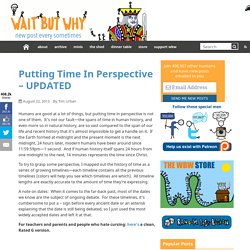
It’s not our fault—the spans of time in human history, and even more so in natural history, are so vast compared to the span of our life and recent history that it’s almost impossible to get a handle on it. If the Earth formed at midnight and the present moment is the next midnight, 24 hours later, modern humans have been around since 11:59:59pm—1 second. And if human history itself spans 24 hours from one midnight to the next, 14 minutes represents the time since Christ. To try to grasp some perspective, I mapped out the history of time as a series of growing timelines—each timeline contains all the previous timelines (colors will help you see which timelines are which).
All timeline lengths are exactly accurate to the amount of time they’re expressing. Identify text features in nonfiction. The Black Death, 1348. The Triangular Trade: The Abolition of Slavery Project. Life at sea in the age of sail : Ships, seafarers & life at sea : Sea & ships fact files : Sea & ships. Heaving a lead by John Augustus Atkinson, 1 January 1807.
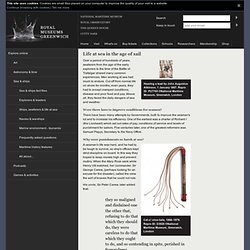
Repro ID: PU7765 ©National Maritime Museum, Greenwich, LondonOver a period of hundreds of years, seafarers from the age of the early explorers to the time of the Battle of Trafalgar shared many common experiences. Men working at sea had much to endure. Cut off from normal life on shore for months, even years, they had to accept cramped conditions, disease and poor food and pay.
Above all, they faced the daily dangers of sea and weather. Were there laws to improve conditions for seamen? There have been many attempts by Governments, both to improve the seaman's lot and to increase his efficiency. Why were punishments so harsh at sea? Cat-o'-nine-tails, 1866–1879. His uncle, Sir Peter Carew, later added that: they so maligned and disdained one the other that, refusing to do that which they should do, they were careless to do that which they ought to do, and so contending in spite, perished in frowardness What were typical punishments? Magna Carta. Myth and history are intertwined in the England of 800 years ago.
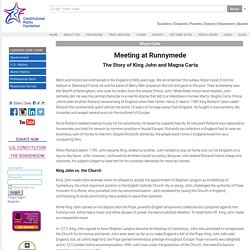
We all remember the outlaw, Robin Hood. From his hideout in Sherwood Forest, he and his band of Merry Men preyed on the rich and gave to the poor. Japan-physical-map-highres.jpg (JPEG Image, 1000 × 863 pixels) - Scaled (84%) Subject 1 Calendar - Hundred Years' War Webquest. The-forbidden-city-map.jpg (JPEG Image, 1550 × 2000 pixels) - Scaled (36%) Spread of Christianity in the Roman Empire, to A.D. 600. The Renaissance - upload.c-krand-9n118.pdf. The Renaissance Connection, from the Allentown Art Museum. 7th Grade: Social Studies: The Renaissance flashcards. 07) Renaissance - 7th Grade World History.
The Galileo Project. The Inquisition The Inquisition was a permanent institution in the Catholic Church charged with the eradication of heresies.
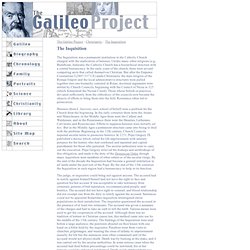
Unlike many other religions (e.g., Buddhism, Judaism), the Catholic Church has a hierarchical structure with a central bureaucracy. Shared Documents - All Documents. World History Resources - PowerPoints, Worksheets, Notes, Quizzes and Tests. The Middle Ages: Feudal Life. Medieval Middle Ages Worksheets. King John and the Magna Carta - Middle Ages for Kids! 12 of the Most Horrifying Torture Devices in History. I’ve sat through all the Saw and Hostel movies, and I wasn’t the least bit affected by all the gore.
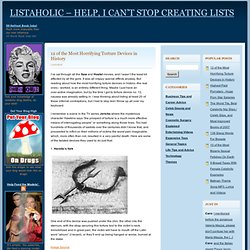
It was all crappy special effects anyway. But reading about how the most horrifying torture devices in history--the real ones-- worked, is an entirely different thing. Maybe I just have an over-active imagination, but by the time I got to torture device no. 12, nausea was already setting in. I was thinking about listing at least 20 of these infernal contraptions, but I had to stop lest I throw up all over my keyboard. I remember a scene in the TV series Jericho where the mysterious character Hawkins says “the prospect of torture is a much more effective means of interrogating people” or something along those lines. 1. Magna Carta. Guide to Life on a Medieval Manor. Joan of Arc Ppt Presentation. Daily Life of a Monk in the Middle Ages. Medieval freebies. Middle Ages. From Academic Kids The Middle Ages formed the middle period in a traditional schematic division of European history into three 'ages': the Classical civilization of Antiquity, the Middle Ages, and modern times, beginning with the Renaissance.
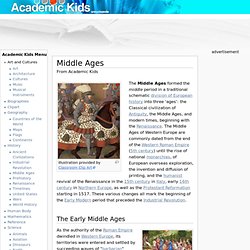
The Middle Ages of Western Europe are commonly dated from the end of the Western Roman Empire (5th century) until the rise of national monarchies, of European overseas exploration, the invention and diffusion of printing, and the humanist revival of the Renaissance in the 15th century in Italy, early 16th century in Northern Europe, as well as the Protestant Reformation starting in 1517. These various changes all mark the beginning of the Early Modern period that preceded the Industrial Revolution.
The Early Middle Ages Although the settled population of the Roman period were not everywhere decimated, the new peoples greatly altered established society, and with it, law, culture and religion, and patterns of property ownership. A new order Technology. Global Food Exchange. The Columbian Exchange Timeline of Important Dates. Pangaea The ancient supercontinent of Pangaea breaks apart as the earth's tectonic forces cause the Americas to begin to drift away from Eurasia.

First Western Humans The first humans to reach the Western Hemisphere—the ancestors of modern Indian populations—migrate from Siberia into the Americas. Maize Inhabitants of Mexico successfully bioengineer maize—one of the world's most efficient sources of carbohydrates—from inedible teosinte grass. Aug 3, 1492 Columbus Sails Christopher Columbus sets sail from Spain, hoping to reach the East Indies by sailing due west across the Atlantic. Make Your Own Illuminations. Illuminated Manuscripts. Intro. The Japan Project - Japanese Culture. Beowulf In Hypertext. Vikings runes.